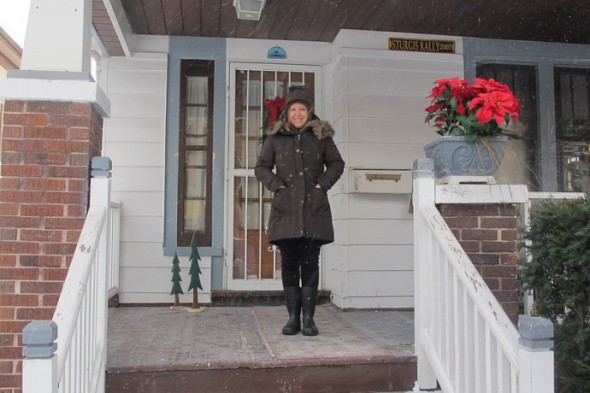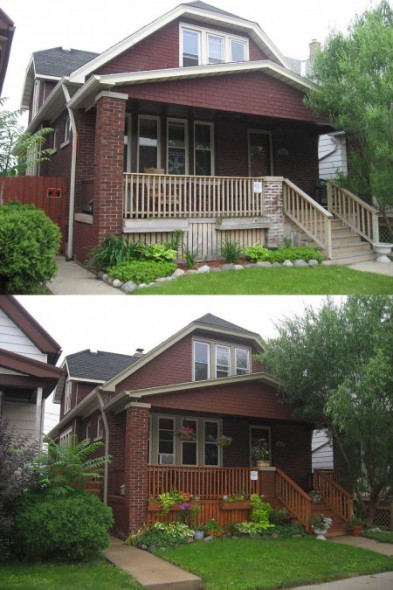Grants Upgrade South Side Neighborhood
Matching grant programs spend $29,000 to leverage more than $154,000 spent by residents to improve their homes.

Julia Nokovic says that without the matching grant, she would have continued to put off much-needed repairs on her Silver City home. (Photo by Edgar Mendez)
Julia Nokovic, an 18-year resident of the Silver City neighborhood, had been putting off fixing her roof for years.
“But I knew the small leaks could become big ones soon,” Nokovic said.
While handing out fliers this summer for Layton Boulevard West Neighbors (LBWN), a non-profit serving her area, she noticed an announcement for a small matching grants program available to residents for home improvement projects. Knowing she would be partially reimbursed for improving her home was all the impetus she needed to go through with repairs she’d been dreading for years.
“They got it done in three days and the work was great,” said Nokovic of the $3,000 project.
The best part of it all, according to Nokovic, was receiving a $500 check.
The $500 matching grant Nokovic received is the result of the School Model Block initiative, which funded matching grants for home improvement projects to residents in the four-block area surrounding Doerfler School, 3014 W. Scott. The initiative is one of 11 catalytic projects created as part of the Quality of Life Plan for the neighborhood, unveiled in 2011.
Three separate matching grant programs are available in the LBWN neighborhood. A $1,000 grant for similar projects, funded by the Zilber Family Foundation, is also available to residents in neighboring Clarke Square, according to Ofelia Mondragon, home improvement coordinator for both neighborhoods. There are no income restrictions for eligibility for that grant, but it’s first come first serve, Mondragon added.
In total, grants of about $29,000 leveraged more than $154,000, a five to one return on investment. Funding for the grants also came from the Wells Fargo Housing Foundation and the Metropolitan Milwaukee Fair Housing Council.
Mondragon calls the grants a motivator.
“We’ve had people buy a door for $100 and get back $50,” said Mondragon, adding that many of those repairs would have gone undone, affecting the look of the neighborhood.
Melinda Rodriguez, who lives in Layton Park, stained her porch, painted the trim on the exterior of her home and put in new flowerboxes.
She said if not for the grants, “I would’ve totally put it off.”
Rodriguez calls the grants an incentive for people in the neighborhood to make repairs they’d been holding off on due to the cost. Seeing so many people in her neighborhood fixing up their homes disproves what Rodriguez said many people think about Milwaukee neighborhoods.
“You hear so many negative things about the city and that people don’t care, but there’s so many people who do care and value where they live,” Rodriguez said.
“A small home improvement matching grant program is an easily replicated model that is relatively low-cost and high return,” Perez added.
Nokovic couldn’t be happier that she took advantage of the program. She said once her roof was done she felt so grateful she went to her room, dropped to her knees and thanked the Lord, adding.
“I helped the neighborhood; I helped myself.”
This story was originally published by Milwaukee Neighborhood News Service, where you can find other stories reporting on fifteen city neighborhoods in Milwaukee.























Thanks for sharing. This is a model that could be easily replicated in neighborhoods throughout Milwaukee in a way that positively impacts neighborhood appearance, pride and confidence. These grants were part of an overall strategy in Silver City, Burnham Park and Layton Park that resulted in over $718,000 in neighborhood home improvement investment. More information about the tools LBWN is using to restore the neighborhood’s quality housing stock can be found at: http://lbwn.org/HousingResources.html
In my younger days when I owned a 1929 constructed duplex in Milwaukee, it was extremely helpful to have any programs that offered low interest loans, grants, rebates, etc. from all available sources. They made all the difference in the world to my family, and a more limited income, at that time in maintaining an older home. The main problem with this approach is that it can be incremental and haphazard in retrofitting an older home. A homeowner routinely is not educated on best practices and a priority approach. Neither are contractors that will sell their small focus of expertise and installation.
The best example is a comprehensive overhaul that LBWN is able to accomplish on vacant homes that they take over. It is rare that any of us can take on this type of process that is sorely needed on thousands of homes and commercial buildings. Only then can we prepare buildings for the 21st Century with sustainability, occupant health and safety, energy efficiency, and renewable upgrades.
The Better Buildings Conference is coming up in March in the Dells. This conference is one of the best at providing comprehensive education on building science. I would recommend it for building contractors, teachers, planners, architects, community group staff that take on these projects, reporters, and anyone interested in buildings.
http://www.betterbuildingswi.org/